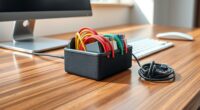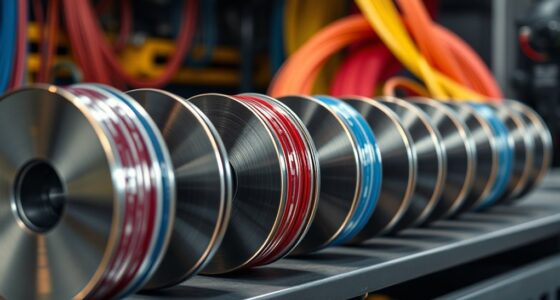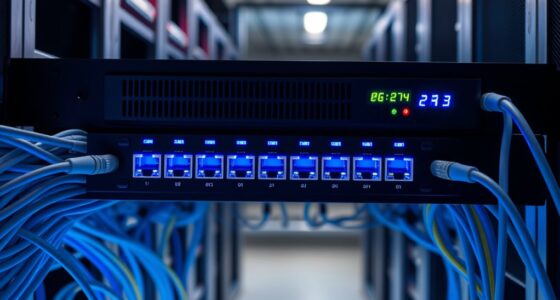If you’re searching for the best OTDR devices for long-haul fiber testing in 2025, I can help. I recommend models that support multiple wavelengths like 1310nm and 1550nm, offer high dynamic range (around 26dB), and have small blind zones for precise pinpointing. Durability, portability, and extensive accessories are essential, too. These devices combine accuracy with reliability, helping you accurately diagnose and maintain fiber networks. Keep exploring, and you’ll uncover more about top choices tailored for demanding field conditions.
Key Takeaways
- Look for OTDRs with high dynamic range (≥26dB) and multiple wavelength support (1310/1550nm) for long-haul fiber accuracy.
- Select devices with extended testing distances (up to 80 km) and ultra-short dead zones for precise fault detection.
- Prioritize models with intuitive touchscreen interfaces, robust construction, and long battery life for field reliability.
- Ensure compatibility with various fiber connectors and accessories like launch cables to eliminate blind zones.
- Consider data storage and transfer features for comprehensive analysis, reporting, and efficient management of large test datasets.
WANLUTECH OTDR Fiber Tester with Touchscreen and Network Tools

If you’re a technician or field engineer looking for a versatile OTDR device, the WANLUTECH OTDR Fiber Tester with Touchscreen and Network Tools is an excellent choice. It supports 1550nm wavelength with a 24dB dynamic range, making it ideal for long-haul testing. The device quickly sets up parameters like wavelength, distance, pulse width, and measurement duration, ensuring precise results. It visualizes fiber links with event maps, stores data for detailed analysis, and generates detailed PDF or Excel reports. Plus, it features a visual fault locator, network tools, and multiple adapters, making it a powerful all-in-one solution for fiber testing in challenging environments.
Best For: technicians and field engineers needing a versatile, all-in-one fiber testing device with network tools and long-distance measurement capabilities.
Pros:
- Supports multiple wavelengths and long-haul testing with a 24dB dynamic range for accurate results.
- Includes comprehensive adapters and accessories for various fiber and cable types, enhancing versatility.
- Visualizes fiber links with event maps, stores data, and generates detailed reports in PDF/Excel formats.
Cons:
- Excludes the charging adapter from the package, requiring an additional purchase.
- The device’s advanced features may require some training for optimal use.
- Limited to 600 meters for RJ45 cable testing, which might be insufficient for very long cable runs.
Mini-Pro 1310/1550nm SM OTDR Tester with OPM/OLS, RJ45 Test, VFL, 5m-60Km Range
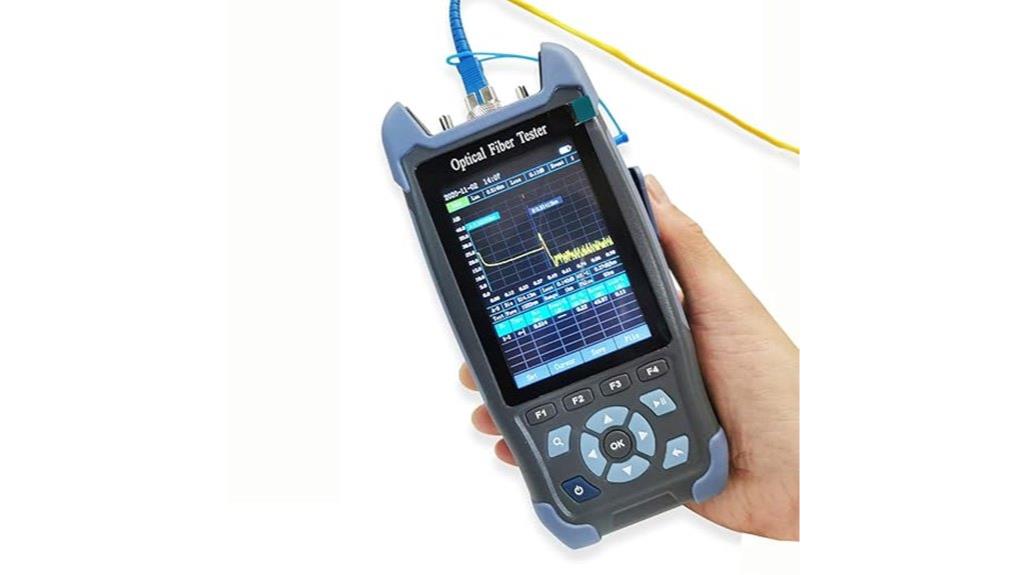
The Mini-Pro 1310/1550nm SM OTDR Tester stands out as an ideal choice for professionals conducting long-haul fiber testing, thanks to its extensive range of 5 meters to 60 kilometers. It’s a versatile device designed for evaluating FTTx and access networks, pinpointing fiber breakpoints, measuring cable length, and calculating optical power loss. With features like OPM/OLS, RJ45 testing, and a VFL, it covers multiple testing needs in one compact unit. Its 3.5-inch color display and integrated analysis software make data review straightforward. Built for reliability and precision, this tester is perfect for demanding long-haul fiber projects.
Best For: professional telecommunications technicians conducting long-haul fiber network testing, maintenance, and troubleshooting.
Pros:
- Wide testing range of 5 meters to 60 kilometers, suitable for long-haul fiber applications.
- Multi-function capabilities including OTDR, Power Meter, Cable Length Measurement, and RJ45 testing, providing comprehensive testing in one device.
- Compact design with a 3.5-inch color display and internal storage options for easy data review and management.
Cons:
- Non-touch display may be less intuitive compared to touchscreen models.
- Requires software installation on a PC for data analysis, which might be less convenient for field use.
- Higher accuracy testing in some scenarios may need more advanced, specialized equipment.
New Upgraded OTDR Optical Fiber Tester
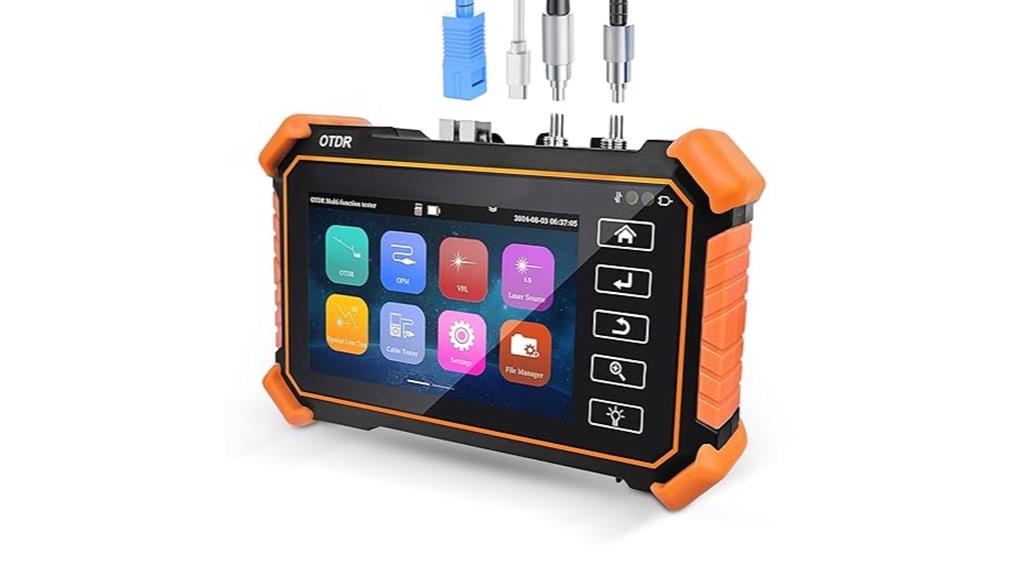
For technicians seeking a reliable and versatile fiber testing tool, the new upgraded OTDR optical fiber tester stands out with its extensive feature set and user-friendly design. It supports 1310nm and 1550nm wavelengths with a 26dB/24dB dynamic range, offering quick setup and professional parameter customization. The device features an intuitive touchscreen, event map visualization, and a compact, handheld form factor, making on-site testing straightforward. It combines multiple functions like fiber fault location, network diagnostics, power measurement, and cable testing. With long battery life and robust construction, this tester guarantees accurate, efficient results across various deployment scenarios.
Best For: professional fiber optic technicians and network engineers needing a reliable, multi-functional testing tool for installation, maintenance, and troubleshooting.
Pros:
- Supports multiple wavelengths (1310nm/1550nm) with high dynamic range for precise measurements
- Intuitive touchscreen interface with event map visualization for quick fault detection
- Long battery life (over 20 hours standby) and robust, handheld design for on-site use
Cons:
- May require training to fully utilize advanced professional parameters
- Limited to fiber testing and basic network diagnostics; not suitable for large-scale enterprise network management
- Slightly higher cost compared to simpler, single-function testers
OTDR Fiber Optic Transmission Launch Cable
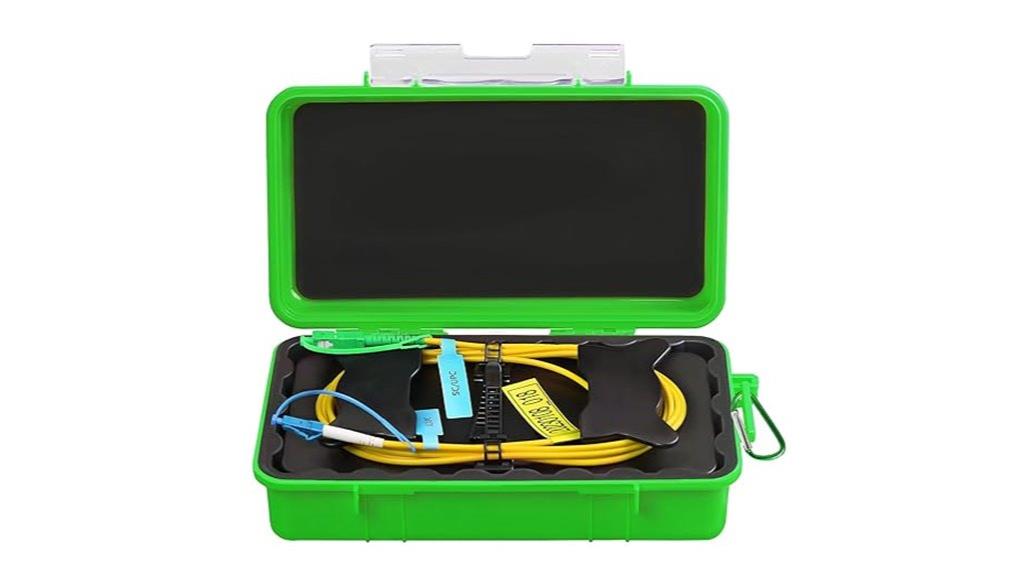
Optical technicians seeking precise fiber testing will find the OTDR Fiber Optic Transmission Launch Cable indispensable, especially since it effectively eliminates dead zones during measurements. This 1 km launch cable extends the testing reach, ensuring accurate loss and reflectivity readings of proximal connections. Its SCAPC to LCUPC interface is compatible with singlemode fiber at 1310nm and 1550nm wavelengths. The cable’s compact, lightweight design makes it perfect for field use, while its dead zone eliminator enhances measurement accuracy. No fusion splices in the middle reduce signal loss, providing reliable, thorough testing for long-haul fiber networks. It’s an essential tool for precise troubleshooting and quality assurance.
Best For: optical technicians and network engineers conducting precise fiber optic testing and troubleshooting in both field and laboratory environments.
Pros:
- Eliminates dead zones, ensuring accurate OTDR measurements.
- Supports up to 1 km of singlemode fiber with minimal signal loss.
- Compact, lightweight, and easy to carry for onsite testing.
Cons:
- Limited to singlemode fiber at 1310nm and 1550nm wavelengths.
- Does not include fusion splices, which may be necessary for some setups.
- Requires familiarity with OTDR testing procedures for optimal use.
JONARD TOOLS OTDR-1000 Multi-Function OTDR

If you’re searching for a versatile testing tool that streamlines fiber optic evaluations, the JONARD TOOLS OTDR-1000 Multi-Function OTDR stands out. It combines OTDR, Event Map, Power Meter, Light Source, VFL, cable length measurement, and cable tracker into one device, making it ideal for all-encompassing fiber network testing. Its built-in features allow for quick, accurate analysis of FTTx and access networks, pinpointing fiber breaks and measuring power loss. With 600 MB internal storage, MicroSD slot, and a rechargeable battery, it’s portable and ready for fieldwork. Plus, the included adapters and software simplify setup and data management, boosting efficiency.
Best For: network technicians and fiber optic professionals seeking a comprehensive, portable testing tool for fiber network construction, maintenance, and troubleshooting.
Pros:
- Combines multiple testing functions (OTDR, Power Meter, Light Source, VFL, etc.) into one device for versatile use
- Built-in features and accessories streamline setup and data collection in the field
- 600 MB internal storage with MicroSD slot and rechargeable battery enhance portability and data management
Cons:
- May be relatively expensive compared to single-function testers
- The device’s complexity could require training for effective operation
- Additional adapters from Jonard Tools are sold separately, potentially increasing overall cost
OTDR A-900D Fiber Optic Tester with Adapters and Accessories

The OTDR A-900D Fiber Optic Tester with Adapters and Accessories stands out as an ideal choice for technicians seeking a versatile and user-friendly testing device. It supports testing up to 60 km at 1310/1550 nm wavelengths and features a 3.5-inch color display, offering multiple functions like OTDR, Power Meter, Light Source, VFL, and more. With interchangeable connectors (SC, FC, ST, LC), it adapts to various testing needs. Its automatic one-key operation ensures accurate, professional results, even for beginners. The device’s extensive data storage options, long battery life, and extensive accessories make it perfect for long-haul fiber testing in demanding field environments.
Best For: technicians and field engineers seeking a versatile, easy-to-use fiber optic testing device with comprehensive features for long-distance and diverse fiber network assessments.
Pros:
- Supports testing up to 60 km with high accuracy and automatic one-key operation for ease of use
- Multiple functions including OTDR, Power Meter, Light Source, VFL, and more, reducing the need for multiple devices
- Long battery life of up to 12 hours and extensive data storage capabilities for extended field work
Cons:
- Non-touch 3.5-inch display may be less intuitive compared to modern touchscreen devices
- Limited dynamic range (24dB/22dB), possibly insufficient for very complex or splintered fiber testing requiring over 42dB
- Reliance on proprietary analysis software which may require additional training or setup
Mini-Pro 1310/1550nm SM OTDR Tester with OPM/OLS, RJ45/VFL Tests, 5m-60Km Range

For professionals seeking a versatile and reliable testing tool, the Mini-Pro 1310/1550nm SM OTDR offers a thorough solution for long-haul fiber analysis. It’s designed to evaluate FTTx and access networks, pinpoint fiber breakpoints, measure cable lengths, and assess optical power losses. With a test range of 5 meters to 60 kilometers, it handles various scenarios with ease. The device features dual-wavelength operation, a 3.5-inch color display, and built-in functions like Power Meter, Cable Length, and VFL testing. Its internal storage and analysis software streamline data management, making it a dependable choice for maintenance and construction professionals.
Best For: Professional fiber technicians and network engineers seeking a versatile, high-precision OTDR tester for FTTx, access networks, and long-distance fiber analysis.
Pros:
- Multi-function device combining OTDR, Power Meter, Cable Length, and VFL testing for comprehensive fiber diagnostics.
- Wavelengths of 1310/1550nm with a wide testing range up to 60 km, suitable for various installation scenarios.
- Compact design with a 3.5-inch color display and internal data storage, facilitating easy on-site analysis and data management.
Cons:
- Non-touch display may be less intuitive compared to modern touchscreen devices.
- Some scenarios requiring extremely high accuracy (>42dB dynamic range) may need specialized equipment.
- External software installation and data transfer may require additional setup and familiarity with PC tools.
2PCS Fiber Optic Visual Fault Locator (VFL) Tester with FC/ST/SC/LC
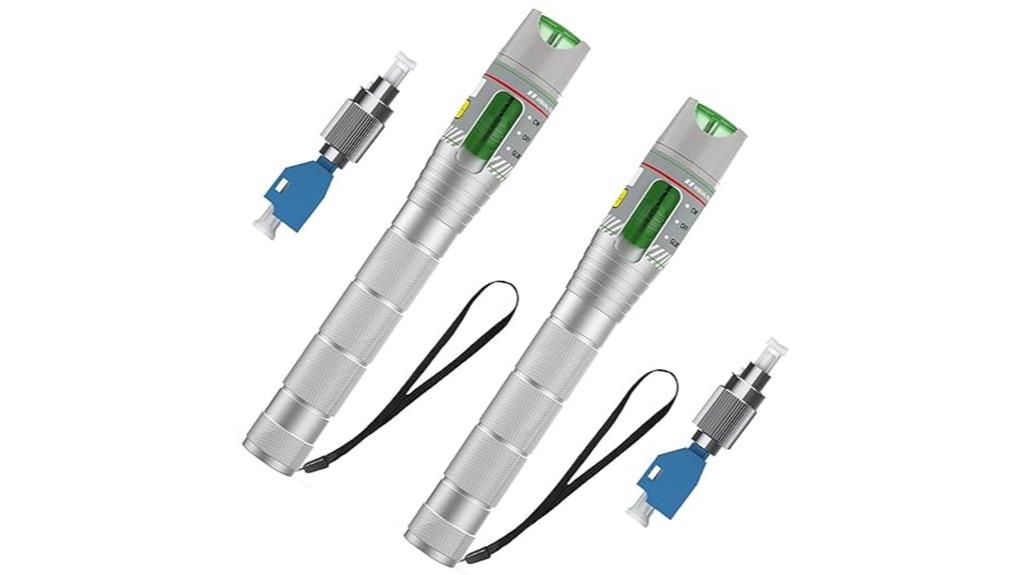
When selecting a reliable tool for fault detection and signal tracing in fiber optic networks, consider the PCS Fiber Optic Visual Fault Locator (VFL) Tester with FC/ST/SC/LC connectors. This device emits visible light over distances up to 100 km, allowing quick identification of breaks, bends, and poor connections. Its compatibility with multiple connector types makes it versatile for various setups. Designed for field use, it offers pulse and continuous modes, long battery life, and durable construction with an aluminium alloy body. Whether for installation, maintenance, or troubleshooting, this VFL simplifies fault pinpointing and guarantees network integrity across different environments.
Best For: telecom engineers, fiber optic technicians, and network professionals seeking reliable fault detection and signal tracing tools for long-distance and dense cabling environments.
Pros:
- Supports multiple connector types (FC, ST, SC, LC) for versatile compatibility.
- Emission of visible light up to 100 km for effective fault pinpointing.
- Durable construction with lightweight design, suitable for field use.
Cons:
- Requires two AA batteries, which may need frequent replacement during extensive use.
- Limited to fiber optic cable testing; not suitable for other cabling types.
- The device’s brightness may be affected in extremely bright ambient conditions.
WANLUTECH Singlemode OTDR Fiber Optic Tester
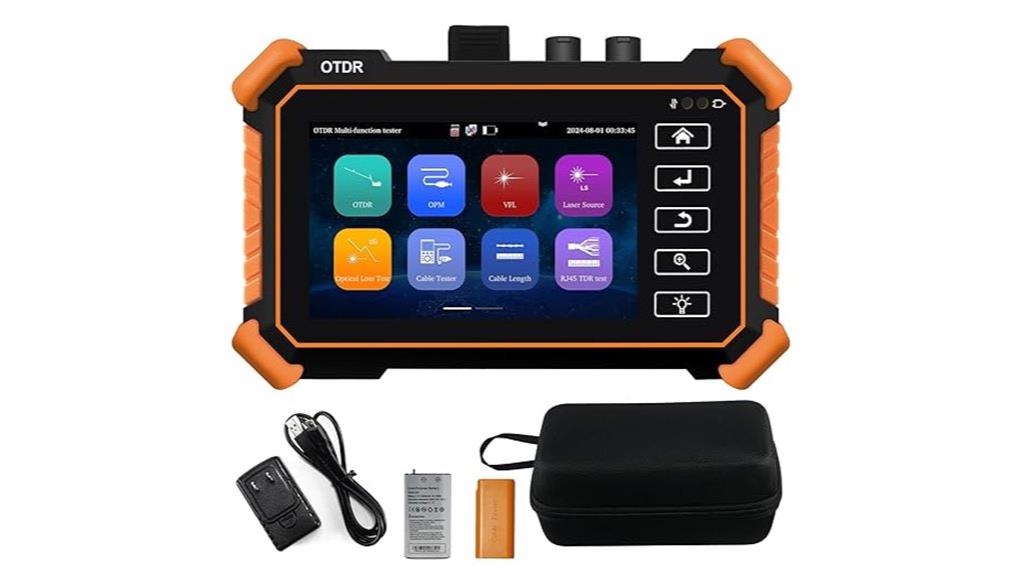
If you’re seeking a handheld OTDR device that balances extensive fiber testing with user-friendly features, the WANLUTECH Singlemode OTDR Fiber Optic Tester stands out. It offers 1310nm and 1550nm wavelengths with a dynamic range of 26dB and 24dB, providing accurate measurements for long-haul fiber links. The device features quick setup options for wavelength, distance, pulse width, and measurement duration, plus a parameters mode for professional adjustments. It includes integrated functions like an optical power meter, visual fault locator, light source, and optical loss test, all stored and visualized via graphical event maps. Its intuitive touchscreen and all-encompassing data reporting make it an essential tool for reliable fiber testing.
Best For: technicians and network professionals seeking a comprehensive, handheld fiber and network testing device with professional features and user-friendly operation.
Pros:
- Combines fiber optic testing with integrated power meter, fault locator, light source, and loss testing for all-in-one functionality.
- Quick setup options and a touchscreen interface simplify complex measurements and adjustments.
- Supports detailed graphical event maps and comprehensive report generation in standard formats.
Cons:
- Cannot test live fiber, limiting use in active network environments.
- Singlemode OTDR with 26dB/24dB range may not suit ultra-long fiber links beyond its specified range.
- Battery capacity, while adequate, may require frequent recharging during extensive testing sessions.
Multimode Fiber Tester with OTDR, OPM, OLS, VFL, Event Map, Data Module, 7 Touch Screen
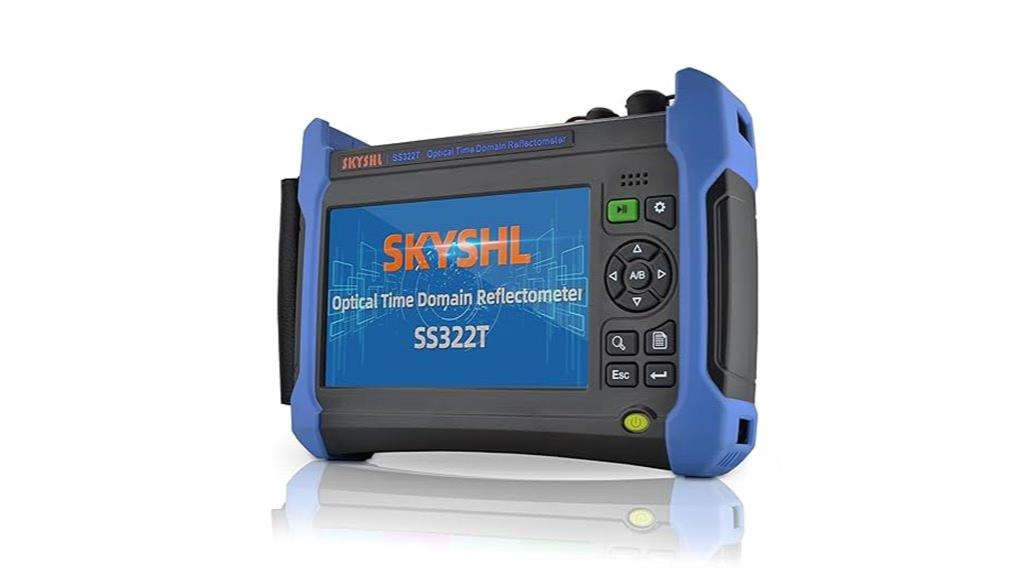
The Multimode Fiber Tester with OTDR, OPM, OLS, VFL, Event Map, Data Module, and a 7-inch touch screen stands out as an all-in-one solution for field technicians and engineers who need extensive fiber testing in a single portable device. It offers dynamic ranges of 29dB at 850nm and 37dB at 1300nm, supporting test distances up to 80km. With ultra-short dead zones and advanced algorithms, it detects close-range faults accurately. Its integrated functions—OTDR, VFL, OPM, and OLS—streamline testing, while the intuitive touch interface and broad connectivity options make data management and analysis effortless in the field.
Best For: field technicians and network engineers requiring comprehensive, portable fiber optic testing with integrated functions for efficient diagnostics and maintenance.
Pros:
- Combines multiple testing tools (OTDR, VFL, OPM, OLS) into a single handheld device for convenience and efficiency.
- Supports long-distance testing up to 80km with ultra-short dead zones for accurate fault detection.
- User-friendly 7-inch touchscreen interface with broad connectivity and multilingual support for easy operation worldwide.
Cons:
- The device may be relatively expensive due to its multifunctionality and advanced features.
- Its size and weight might be less ideal for extended handheld use compared to simpler testers.
- Requires familiarity with fiber optic testing concepts for optimal utilization of all integrated features.
Fiber Optic OTDR Launch Cable for FTTH Testing

A fiber optic OTDR launch cable is essential for anyone performing FTTH testing, especially when accuracy near connection points matters most. It helps eliminate blind zones, allowing precise measurements close to connectors and splices. Designed with single-mode 9/125μm fiber supporting 1310nm and 1550nm wavelengths, it’s compatible with APC and UPC connectors, ensuring reliable results. Available in various lengths—150m to 2000m—it adapts to different testing scenarios. Its low signal loss (~0.2dBm/km) and durable construction make it suitable for field use. A portable, protective box makes deployment easy, ensuring consistent, accurate fiber link testing across diverse environments.
Best For: technicians and engineers performing FTTH testing who need accurate fiber link measurements near connection points.
Pros:
- Eliminates blind zones for precise near-connection testing.
- Supports multiple lengths and compatible with various connectors and wavelengths.
- Durable construction and portable design ideal for field deployment.
Cons:
- Limited to single-mode 9/125μm fiber, not suitable for multimode applications.
- May be more expensive compared to basic launch cables.
- Longer lengths can be less flexible and more cumbersome to handle.
OTDR Fiber Optic Launch Cable with LC/UPC Connectors, 500M Extension Cord
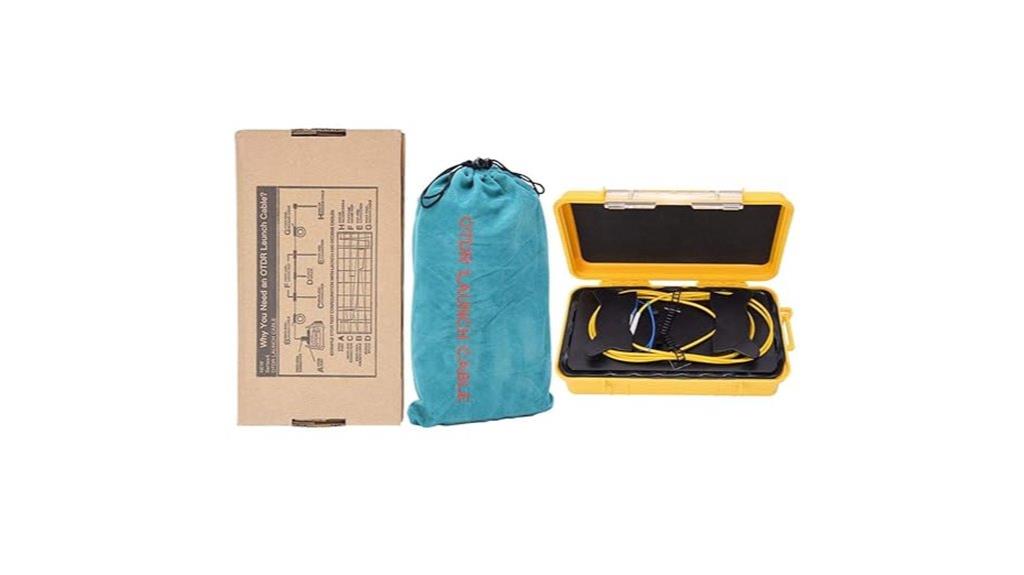
For professionals seeking precise OTDR measurements, the OTDR Fiber Optic Launch Cable with LC/UPC connectors and a 500-meter extension offers a reliable solution. This extension cord is designed to eliminate blind spots in testing, ensuring more accurate results. Its construction features no fusion joints in the fiber core, maintaining signal integrity and reducing loss. With a low loss rate of ≤ 0.5dBm/km, it provides consistent performance over long distances. Its compact, lightweight design makes it easy to transport and set up, making it an essential tool for reliable, long-haul fiber testing.
Best For: professionals and technicians performing long-distance OTDR testing who need precise, reliable fiber optic measurements with minimal signal loss.
Pros:
- Eliminates blind spots for more accurate OTDR testing results
- No fusion joints in the fiber core to maintain signal integrity and reduce loss
- Lightweight and compact design for easy transport and setup
Cons:
- May require careful handling to prevent fiber damage over long distances
- Limited to single-mode fiber; not compatible with multimode applications
- Installation and connection may require specialized training for optimal performance
Optical Fiber FTTH Loss Tester Kit with Power Meter, Light Source, VFL, and Jump Cable

If you’re focused on precise fiber testing for FTTH deployments, the Optical Fiber FTTH Loss Tester Kit offers an all-in-one solution that simplifies your workflow. It includes a power meter, light source, VFL, and jump cable, making it versatile for construction, inspection, and cleaning. The kit measures -70 to +10dB across 7 wavelengths, guaranteeing accurate loss testing. The visual fault locator helps detect fiber faults quickly, while the ergonomic, waterproof design ensures durability and ease of use in the field. This extensive toolkit streamlines testing, fault locating, and maintenance, providing reliable results for FTTH fiber deployment projects.
Best For: technicians and engineers conducting precise fiber optic installation, inspection, and maintenance in FTTH deployment projects.
Pros:
- Comprehensive all-in-one toolkit with power meter, light source, VFL, and jump cable for versatile testing.
- Accurate loss measurement across 7 wavelengths (-70 to +10dB), ensuring reliable results.
- Durable, waterproof, and ergonomic design suitable for field use and easy transportation.
Cons:
- May be more expensive than basic testing tools for casual or small-scale projects.
- Requires some training to fully utilize all testing features effectively.
- Limited to fiber optic testing; not suitable for non-fiber cabling solutions.
Factors to Consider When Choosing OTDR for Long Haul Fiber Testing
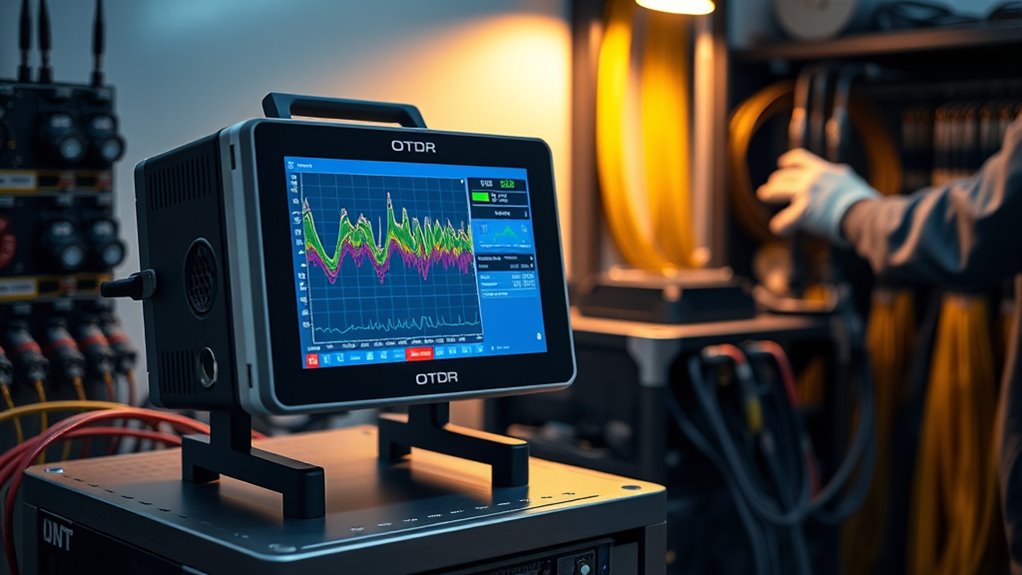
When selecting an OTDR for long-haul fiber testing, I focus on key factors like wavelength compatibility, dynamic range, and test distance limits to guarantee accurate measurements. I also consider the device’s blind zone size and data storage options, which are vital for efficient testing over extended distances. Understanding these points helps me choose an OTDR that meets the specific demands of long-distance fiber networks.
Wavelength Compatibility
Selecting an OTDR that supports the correct wavelength range is vital for precise long-haul fiber testing. Typically, you’ll need devices that operate at 1310nm and 1550nm, as these are standard for loss and reflection measurements over long distances. Compatibility with multiple wavelengths enhances versatility, allowing you to test different fiber types and passive components like splitters and connectors effectively. Wavelength-specific dynamic range and resolution are critical for detecting faults at extended distances, so choose an OTDR optimized for your network’s length. Additionally, extended wavelengths such as 1625nm can be beneficial for specialized tasks like fiber monitoring or leakage detection. Always confirm that the OTDR’s wavelength support aligns with your fiber’s specifications to ensure thorough, accurate testing across your entire network.
Dynamic Range Power
A higher dynamic range in an OTDR is vital for accurate long-haul fiber testing because it determines how well the device can detect weak reflections and minor faults over extended distances. With a dynamic range of 26dB or more, I can test fibers exceeding 50 km without losing measurement accuracy. This capability is essential for reliable event detection and loss measurement across long spans. Lower dynamic range OTDRs might need additional equipment like launch fibers or repeaters, complicating the testing process. When selecting an OTDR, I look for at least 24-26dB dynamic range to guarantee sensitivity and precision in detecting subtle faults and signal attenuation. This power directly impacts the device’s ability to provide trustworthy results over the full length of long-haul networks.
Blind Zone Size
In long-haul fiber testing, a small blind zone size is essential because it allows me to detect events and faults close to the fiber connector with greater accuracy. A smaller blind zone—typically under 1.6 meters—means I can pinpoint issues right near the connector, avoiding missed faults or splices. High-quality OTDRs feature an attenuation blind zone of less than 8 meters, which helps me accurately measure signal loss near the source. If the blind zone is too large, events close to the OTDR launch point might be hidden, leading to potential misinterpretations of the fiber’s condition. Choosing an OTDR with a minimal blind zone ensures I get detailed, reliable data, especially in complex or densely packed network environments where precision is critical.
Test Distance Limits
When choosing an OTDR for long-haul fiber testing, understanding the test distance limits is essential because they determine how far I can accurately measure and locate faults along the fiber span. These limits are primarily influenced by the device’s dynamic range; higher ranges support longer distances, often exceeding 60 km. However, the fiber type also matters—singlemode fibers typically allow for longer testing distances than multimode, due to differing attenuation levels. Additionally, the OTDR’s event and attenuation blind zones affect measurement accuracy over extended spans. Calibration quality and environmental factors like connector health, splice quality, and fiber conditions also impact effective testing range. Knowing these factors helps me select a device that guarantees reliable, precise measurements across the entire length of the fiber network.
Data Storage Options
Choosing the right data storage options is essential because long-haul fiber testing generates large amounts of data that need to be stored securely and efficiently. I look for OTDRs with ample internal memory or support for external storage like TF cards or USB drives, ensuring I can handle extensive test datasets. Export options in common formats such as PDF or Excel are crucial for easy analysis and record-keeping. I also prefer devices that allow saving multiple test curves and parameters separately, making it easier to compare results over time. Data transfer capabilities via Ethernet, Bluetooth, or Wi-Fi are vital for quick sharing and backups. Lastly, I verify that storage capacities meet the volume of data generated during comprehensive testing, avoiding any limitations that could hinder my workflow.
Portability & Durability
Long-haul fiber testing often takes place in challenging environments, so selecting an OTDR with strong portability and durability features can make all the difference. A rugged, weather-resistant design guarantees the device can withstand harsh field conditions and continue performing reliably. Lightweight, compact models with long battery life—over 12 hours of continuous use—are essential for efficient testing in remote locations. Durable, high-quality materials and shockproof casings reduce the risk of damage during transport and on-site handling. Easy-to-carry accessories like protective cases, shoulder straps, or built-in handles facilitate quick setup and movement across extensive testing sites. Additionally, long-lasting batteries and support for quick recharge cycles help maintain continuous operation during extended deployments, ensuring your testing remains seamless and efficient.
Frequently Asked Questions
How Do Environmental Conditions Affect OTDR Accuracy?
Environmental conditions can considerably impact OTDR accuracy. I’ve found that temperature fluctuations cause fiber expansion or contraction, affecting measurement precision. Humidity can lead to moisture ingress, potentially damaging equipment and skewing results. Vibrations from nearby machinery introduce noise, reducing clarity. To guarantee accurate readings, I always protect devices from extreme weather, stabilize the environment where testing occurs, and perform calibration when conditions change unexpectedly.
What Maintenance Is Required for Long-Term OTDR Performance?
Regular maintenance keeps my OTDR performing at its best. I always check connectors for dirt or damage, clean the launch and receive cords, and calibrate the device periodically. Ensuring firmware updates are current also prevents unexpected issues. This ongoing vigilance not only guarantees accurate measurements but also extends my device’s lifespan, revealing that proper maintenance is the secret to long-term reliability and precise fiber testing.
Can OTDRS Detect All Types of Fiber Faults?
OTDRs are excellent for detecting many fiber faults, like breaks, bends, and splices, but they might miss very small or subtle issues such as micro-bends or certain chemical degradations. I always recommend combining OTDR testing with other diagnostic tools for thorough analysis. This way, you guarantee your fiber network remains reliable, minimizing downtime and troubleshooting time.
How Do Different OTDR Models Compare in Testing Speed?
Did you know some OTDR models can test fiber lengths up to 80 km in just a few minutes? When comparing testing speeds, newer models often outperform older ones, offering faster data collection and analysis. I’ve found that high-end OTDRs can complete long-haul testing in roughly 50% less time, saving valuable hours. So, if speed is critical, investing in the latest technology really makes a difference.
Are There Compatibility Issues With Various Fiber Connectors?
I’ve found that compatibility issues with fiber connectors can vary between OTDR models. Some devices require specific adapters or testing modules for certain connectors like SC, LC, or FC. To avoid problems, I always check the device’s specifications and carry the right adapters. This way, I guarantee smooth testing without interruptions, especially when working with diverse fiber infrastructure.
Conclusion
Choosing the right OTDR device is like finding a needle in a haystack, but with careful consideration, I can guarantee accurate long-haul fiber testing. Whether it’s a compact tester or one with advanced network tools, knowing what to look for helps me avoid pitfalls and get reliable results. Remember, investing in quality today saves me from headwinds tomorrow. Stay informed, choose wisely, and I’ll keep my fiber network running smoothly without missing a beat.

